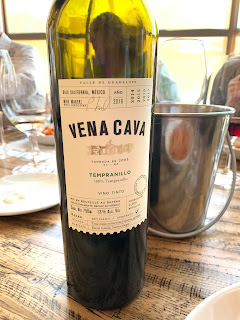 |
| Tour guide in Israel holding up a map of the Golan Heights |
The Holidays are my favorite time of year. I grew up decorating a Christmas tree with my Grandma, making certain foods, and enjoying the “chilly” California nights. About five years ago I converted to Judaism before I got married, and it was one of the best decisions I ever made. I now identify with a culture and a people and it has opened up my world in ways I could never imagine. The benefit of being a convert to Judaism around the holidays is that you can easily split up the family visiting duties! We spend Christmas time with my family and Hanukkah with Aaron’s family. A perfect balance! As we get ready to light the Hanukkah candles this weekend, I am remembering my trip to Israel in 2017.
In January of that year I visited Israel as part of the Honeymoon Israel group. This was a trip for young Jewish couples to connect with their Judaism. Our group consisted of LGBT couples, ally couples, mixed race couples, and interfaith couples. Quite the diverse group. The trip did not shy away from “complicated” history of Israel and the ongoing conflicts. As a part of the trip we visited the Golan Heights area in the north, which is just a few hundred feet from the Syrian border. At the time I was immersed in learning about Israel and trying to understand the complicated nature of life in the Middle East.
 |
| Signs in the Golan Heights, a few hundred feet from the Syrian border |
Fast forward to 2019 and I was asked to attend a press luncheon for the Golan Heights Winery. Quite a different topic of study here! But I was excited to explore winemaking in a region with such a rich history. Golan Heights Winery (and Galil Mountain Winery) fall under the Yarden, Inc. umbrella. The seminar took place at Gwen in Los Angeles with Victor Schoenfeld, head winemaker since 1992, walking us through the Yarden portfolio.
 |
| Victor Schoenfeld, head winemaker |
There is evidence of winemaking in Israel from 5,000 years ago. Israel is uniquely situated on the eastern Mediterranean at the intersection of Europe, Asia, and Africa. The Yarden certified sustainable vineyards are at a high elevation (1300-3900 feet) and on volcanic soils. According to Victor, the role of elevation is critical. Without elevation they could not make wine as it would be too hot. With such a rich (and old!) history of winemaking, you might wonder why there are not indigenous varieties in the area. That’s because the land was under Muslim (read: no alcohol) rule in the 7th century and all indigenous varieties were lost.
Kosher wines have had a bad reputation because of Manischevitz and the old method of heating or cooking wine to keep it kosher. Don’t let those past experiences taint your view of Israeli and/or Kosher wines. Kosher wines can be wines of quality. In fact, Yarden is one of the leaders in quality Kosher wines. Wines that can stand on their own against other world-class wines.
Also, expect to see more Israeli wines in the US. According to Victor, 75% of their wines are consumed in Israel and 25% are exported. However, export is a huge focus at the moment.
 |
| The Tasting Lineup |
And here are the wines I sampled:
Yarden Blanc de Blancs 2011 (SRP $32.99)
Bubbles from Israel! This is a 100% Chardonnay traditional method sparkling wine. Bone dry with only 4-5 g/L of residual sugar (RS). Great citrus/green fruit character moving into toasty baguette-like notes.
Yarden Sauvignon Blanc 2018 (SRP $19.99)
Partial oak aging with 25% of this wine fermented in French oak. Lots o’ tropical fruit (especially on the palate) and a full body. Persistent acid.
Yarden Katzrin Chardonnay 2017 (SRP $38.99)
Ripe fruit that covers the spectrum: citrus to stone to tropical. Oak and creamy notes abound plus some florals. This wine is aged sur lie for 9 months in new French oak.
Yarden Merlot 2014 (SRP $30.99)
A standout, complex Merlot! Red plus black fruit, orange peel, dried sage, earth, and bitter chocolate on the palate. Fabulous acid and well-integrated tannins. Overall a very balanced wine. 18 months in French oak.
Yarden Merlot Odem Organic Vineyard 2014 (SRP $109.99)
A vineyard designate Merlot that shows earthier than the previous Merlot. A slight green, pyrazine note (bell pepper) plus sweet tobacco and chocolate. This wine is fermented and aged sur lie in French oak for 7 months.
Yarden Petit Verdot 2015 (SRP $38.99)
Loved this wine! Very dark in color, as Petit Verdot usually is. Dark black fruit plus floral (violet), spice, and chocolate notes. This wine is aged 18 months in French oak (40% new).
Yarden Cabernet Sauvignon 2015 (SRP $35.99)
At first I wasn’t too impressed with this one. The tannins were a bit weak and I felt this wine wasn’t as assertive as it could be. According to Victor, this wine is in its dormant phase and will improve with age. We shall see! Aged 18 months in French oak (40% new).
Yarden Cabernet Sauvignon Bar’on Vineyard 2014 (SRP $105.99)
A lovely Cab. With a juxtaposition of deep dark fruit (New World style) and an earthy/dusiness (Old World style). Victor says this wine has one foot in the Old World and one foot in the New World. Which is actually a perfect analogy for Israel as a country. Aged 18 months in French oak.






















